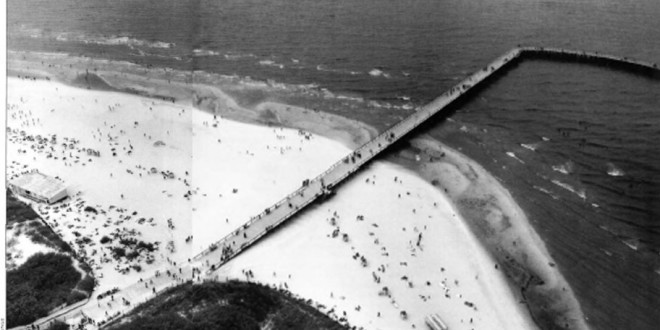BY VYTAS KERNIUS
PALANGA
Yesterday ….. and Today
Lithuania’s most popular beach resort is probably the finest in the Baltics. With its long history intertwined with legends, it looks to a bright future.
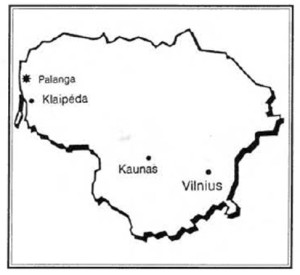
PALANGA, Situated a few miles north of the port city of Klaipe da, is the most famous and popular Lithuanian seaside resort on the Baltic shore.
Early history
Palanga is a very old settlement. Archaeological remains dating from the N eolithic p erio d (3,500-1,800 B.C.) have been uncovered in the area. These include stone, bone, and horn artifacts, as well as amber artifacts and ornaments. A vessel with Greek and Roman coins from the first century A.D. was also found. Danish and Swedish Vikings raided the environs of Palanga during the 9th-llth centuries. It is believed that there was a port in Palanga already in the 12th century that was used by the Danish king Valdemar I to disembark his army.
Palanga is mentioned for the first time in historical records in 1257 in a document between the Lithuanian king Mindaugas and the Teutonic Knights of Livonia. It appears again in 1258 in an agreement between the Bishop of Courland and the Livonian Order by which they partitioned certain territories adjacent to the Baltic coastline.
During the 13th century Palanga became an important wedge, separating Prussia from Livonia and preventing the merger of the two branches of the Teutonic Order. Although the Order tried to seize Palanga by war and negotiations, their efforts were fruitless. It is recorded that in 1409 the Samogitians defeated a force of Teutonic Knights in the vicinity of Palanga, burned their castle, and expelled them from Samogitia. With the exception of a brief period at the beginning of the 15th century, Palanga remained under Lithuanian rule.
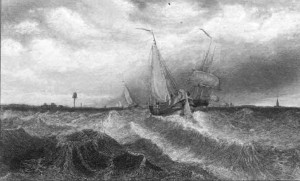
A royal estate was established in Palanga in 1511 and its administration was entrusted to the Kesgaila family of magnates. The estate and the township of the same name were subsequently adm inistered by various families of nobles. The first Catholic church was built in 1554.
During the l6th century Palanga became an important harbor, used by Dutch, Swedish and English ships. In 1598 King Sigismund Vasa had the harbor enlarged, and King John Sobieski allowed the establishment of an English trade representation. During the 16th-17th centuries trade was conducted with Konigsberg (Karaliau cius), Danzig, Liepaja, Riga, and other Baltic ports. Imports included manufactures, haberdashery, salt, iron and arms, while exports consisted of timber, flaxseed, honey, beeswax, furs, hides, cattle and grain. Because Palanga com peted with the Livonian ports of Liepaja and Riga, Riga’s merchants asked the Swedes to destroy Palanga’s port, which they did in 1701 at the time of the Great Northern War.
The 19th century
Some one-and-a-quarter centuries later (1824), the Palanga estate was acquired by a branch of the Counts Tiš kevicius (Tyszkiewicz) family who made it into their residence. They also made an attempt to revive the harbor and port by building an oak pier (called bridge to this day) jutting out into the sea for the mooring of boats and a warehouse for the storage of goods. The family acquired a small steamboat of their own which sailed the Palanga-Liepaja route. But the harbor was gradually covered with sand, and the idea of a port was abandoned. Since 1892 the bridge has been a distinctive landmark of Palanga and has been serving as a promenade area for vacationers.
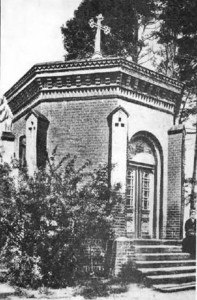
The celebrated Polish poet of Lithuanian ancestry, Adomas Mickevicius (Adam Mickiewicz), spent the summer of 1824 in Palanga and immortalized its beauty in his poems.
The first pharmacy opened in Palanga in 1827 and it’s still in operation. Its most famous product was Trejos devynerios or “999” (“Three nines”), a mixture of 27 herbs concocted according to an ancient folk recipe. This “medicine” was meant to cure many illnesses and became extremely popular not only in Lithuania but also abroad. A version of the recipe was mixed with alcohol and sold as a liquor. At one time the mixture could also be obtained in the United States.
During the great insurrection against czarist oppression in 1831, a large portion of Palanga burned down. After the fire, many new houses were built and the town recovered.
The development of the Tiškevicius estate lasted most of the 19th century. At the initiative of Count Mykolas (Michael) Tiškevicius, a 70-hectare park, designed by a French architect, was created in 1890-1899- More than 150 kinds of trees and shrubs were planted. With its lagoons, bridges, fountains, statues, pathways, and a multitude of exotic plants and birds, it was the most beautiful park in Lithuania. A two-story Renaissancestyle palace and a chapel were built in the park in 1897. It became the summer residence of the Tiškevicius family, and a gathering place for many magnates. A monumental statue of Christ with outstretched arms, created by the famous Danish sculptor Thorvaldsen, was erected in front of the palace.
Palanga was the site of the first Lithuanian play in czarist-occupied Lithuania — V. Vilkutaitis-Keturakis’ Amerika Pirtyje (“America in a steambath”). The play was staged in 1899 in a warehouse which had been converted into a theater. Since the play had patriotic overtones, it displeased the czarist authorities. After the performance, a number of those who participated in the play were imprisoned, and its initiator was exiled to Siberia for five years.
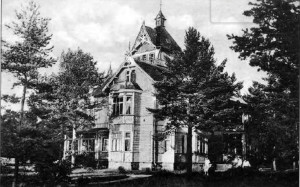
“Jūratė” shown in this early photograph.
Hoping to make Palanga an exemplary resort town, Count Tiškevicius began a number of reforms and improvements. Part of the estate’s land was laid out as a resort area; a spa hotel and several villas were built; electricity was brought in; an artesian well was drilled; plans for sewerage and water supply were completed. All this was interrupted by the First World War and the German occupation.
More recent times
During the early days of independent Lithuania, the Latvians occupied Palanga for a short time. In 1921, after a boundary betw een the two Baltic countries was negotiated, Palanga was attached to Lithuania.
Between the two world wars, the development of the resort was taken over by the Lithuanian government, which granted Palanga the rights of municipality. Palanga became a favorite summer vacation site for the President of Lithuania, many high officials, writers and artists, as well as the general public. Several significant advantages contributed to this: a broad and spacious bar of pristine sand with a long chain of undulating dunes, a temperature higher than the annual average, very few clouds, high amounts of ozone and iodine in the air, mineral water for drinking and for curative baths obtained from artesian wells, and spectacular sunsets. In addition, the town is surrounded by pine forests that provide fresh, healthy and aroma-filled air. The town was also known for its cultural life. Concerts, plays and other programs were held at the park almost every evening.
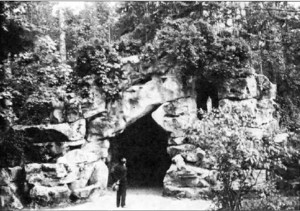
Another fire in 1938 destroyed over 300 houses and caused great financial damage. The Pope donated 10,000 Italian liras to help those afflicted. The burned wooden houses were replaced with brick ones Perhaps nothing attracted more visitors to Palanga than Birute’s Hill. It is a place shrouded in myths and legends and romanticized in poems and songs. The pine covered hill is believed to be the resting place of Birute, wife of King Kestutis (1345-1382) and mother of Vytautas the Great (1392-1430).
According to ancient traditions, Birute was the only daughter of a Palanga nobleman. Others believe she was the daughter of a fisherman. Birute was a vaidilute, a priestess who guarded the sacred fire of an altar dedicated to the goddess Praurime. The meeting of Kestutis and Birute became a beautiful legend (see sidebar on page 9), but many regard it to be historic fact.
It is said that after Kestutis died, Birute returned to her native place where she lived until her death. She was buried on top of the hill that was later named after her.
Lithuanians, and in particular Samogitians, regarded Birute in high respect and esteem. After her death some believed her to be a saint. Pilgrims visited her burial site in droves. To discourage people from what the local religious authorities saw as a resurgence of ancient pagan beliefs, a miniature wooden chapel was built on the hill in the l6th century. The present red brick chapel was constructed in 1869, and a full-scale replica of the Lourdes grotto with a statue of the Virgin Mary was built on the hill’s slope in 1898. 
Prior to the First World War Palanga used to attract 4,000-5,000 guests per season; during the independence period the number rose to about 15,000; and after World War II the total of vacationers jum ped to over 100,000, most of them coming from Soviet Russia. Even communist party bosses from Moscow loved to spend their vacations here. Some, Brezhnev among them, had their own private resort “dachas” built.
Palanga was expanded by incorporating four nearby villages, the northern limits of the town reaching the Šventoji river. The old streets and public squares were enlarged and new streets were laid out. Several larger villas were built to accommodate members of various trade and professional organizations and party members. The park was transformed into a botanical garden, while the palace was given over to the Artists’ Association. In 1963 the palace was converted into the Amber Museum. The statue of Christ was removed, and both the chapel and the “Lourdes” grotto were desecrated. The sea bridge was left to deteriorate.
Palanga today
How does Palanga look today? Those who still remember the way it looked before the war, or who visited Lithuania during the Soviet period, would hardly recognize it now. It is not only a resort town, but a commercial town as well. Most of the buildings on Vytautas Street, the town’s main thoroughfare, which used to be places of rest and relaxation, are now occupied by bars, restaurants, barber and beauty shops, book stores, a library, a minigolf course, tennis and basketball courts, and a parking lot. And Basanavicius Avenue, the boulevard which leads to the bridge and which has been the favorite route for strolling visitors for more than a century, is now lined with bars and restaurants blasting loud music day and night. Although nightlife in Palanga often extends into the early hours of the morning, residents and vacationers have pressured local authorities to pass ordinances limiting loud music to midnight.
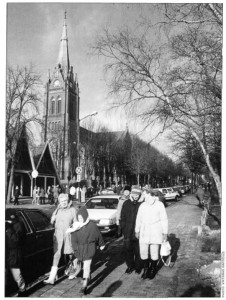
The city has some 2,000 registered businesses, but about 90 percent of them are engaged in some type of commerce, and only three — a bakery, a candy maker, and a food processing plant — manufacture anything. Six large construction firms are also registered. At the end of the 19th century amber processing was the town’s main industry. It employed 500 workers to process approxim ately 20,000 kg. of amber annually. Later, the number of workers was reduced to about 100 to process 8,000 kg. of amber annually for art items and other products. Today the exact number of people engaged in the processing of amber is not known, although quite a few are engaged in its sale.
Because of old age, and the effects of pounding waves and devastating storms, the popular sea bridge became unsafe and had to be torn down. Construction of a new bridge began in 1994. It was re-opened in 1997 and today it is just as popular with strolling vacationers as the old one was.
Before his election as president of Lithuania, Valdas Adamkus visited the resort town and remarked that “Palanga is one of those cities which, because of the construction going on and the variety of its business establishments, it is getting closer to European standards. I was very impressed with what I saw in Palanga, which makes me believe that all foreign visitors will regard it equal to the other famous resort spots of the world.”
Last year, on the 100th anniversary of the construction of the palace, the heir of the Tiškevicius estate, 84-yearold Count Alfred Tiškevicius, was declared Palanga’s first honorary citizen in a ceremony held in the resort city. Count Tiškevicius and his wife live in Poland but spend their summer vacations in Palanga. A highlight of the ceremony was the Count’s assurance that he would not ask for the return of the estate and the palace. Instead, he will donate them to the people of Lithuania. In return, he asked for a resort home and a monthly pension for himself and his wife for life.
 DRAUGAS NEWS Lithuanian World Wide News in English
DRAUGAS NEWS Lithuanian World Wide News in English
